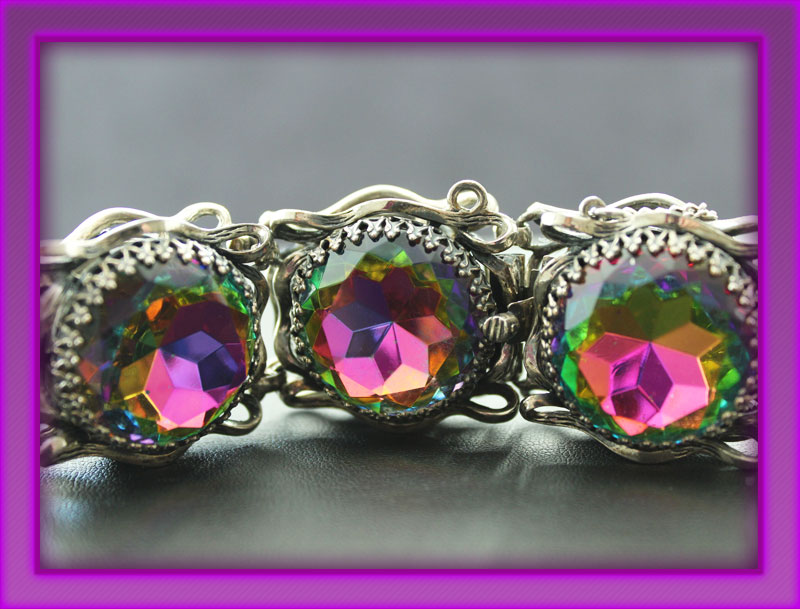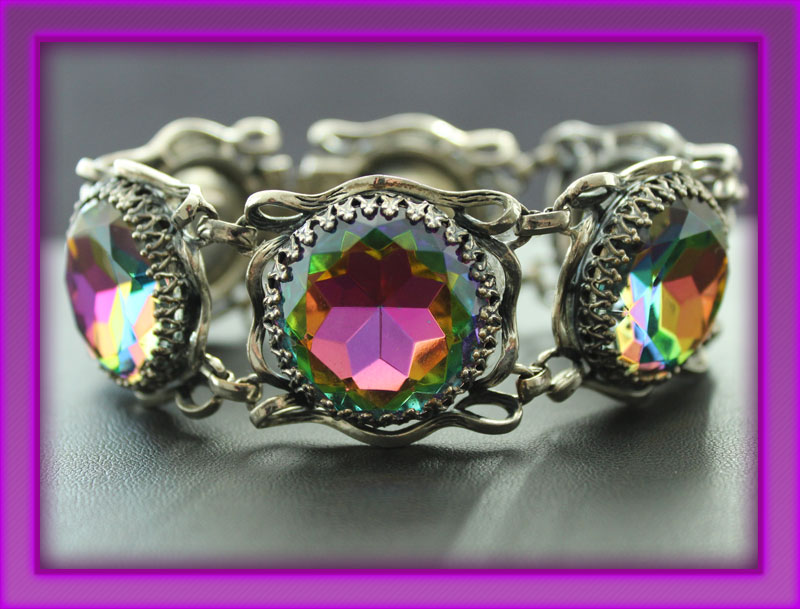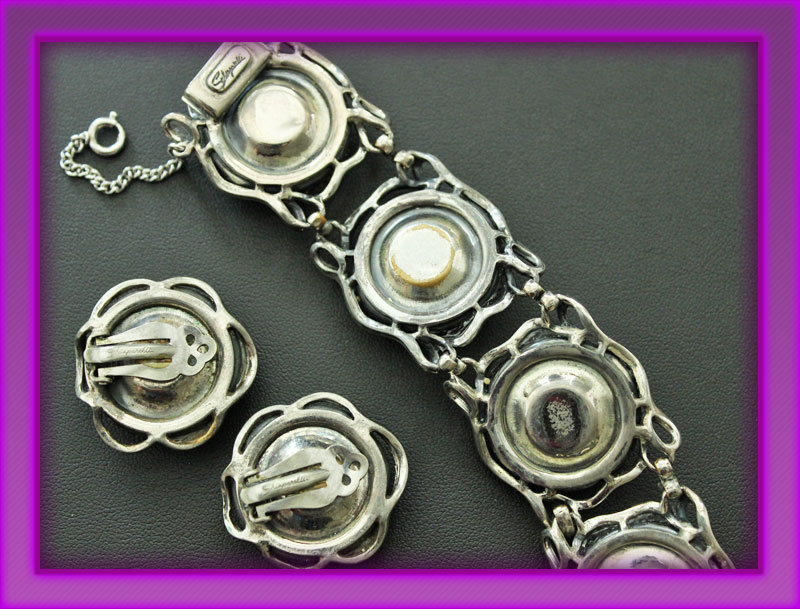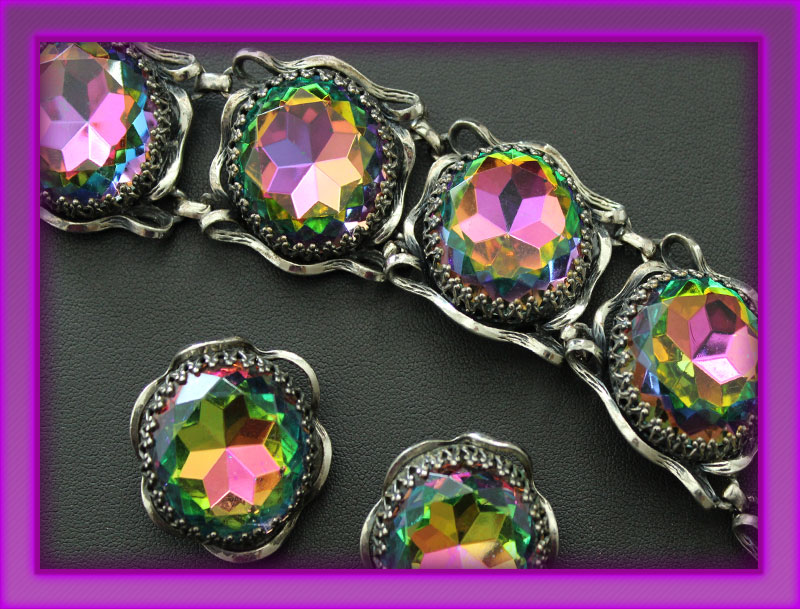Return To Previous Page
Schiaparelli | Watermelon/Heliotrope Bracelet and Earrings
Schiaparelli | Watermelon/Heliotrope Bracelet and Earrings
. . . . Hypnotic!
Schiaparelli
This is a truly stunning Schiaparelli bracelet and earring set. The bracelet has six chain-linked elements, each containing one huge round watermelon/heliotrope rhinestone in a crown edge prong setting. Each rhinestone is a veritable rainbow of color. The total length of the bracelet is approximately 7 1/2", and it is 1 1/2" at its widest point. It has a fold over clasp and safety chain and all pieces are signed in script. There are minor abrasions to the silvertone on the reverse of the bracelet otherwise this rare set is in good vintage condition. ID-SCH
The Earrings — Approximately 1 ¼ inches wide.
Measurements:
The Bracelet — Approximately 7 ½ inches in length.The Earrings — Approximately 1 ¼ inches wide.
Schiaparelli Jewelry History —
Elsa Schiaparelli was one of the most influential designers of the 20th Century, and her innovative and experimental approach, which pushed the boundaries of accepted taste, continues to influence designers today. She was born in Rome in 1890 into a famous and cultured family which lived in a Renaissance Palazzo.
In the 1920's, after a failed marriage, she was drawn to Paris where most of the leading lights in the artistic world had gathered, and she was able to indulge her passion for the arts and fashion in this cultural maelstrom. She became friends with a number of artists, particularly those in the avant garde including Dali, Cocteau and Man Ray.
Schiaparelli with Dali—


She began by designing clothing and was soon seen as a rival to Coco Chanel. However, while Chanel's aesthetic was elegant and based on classic styles, Schiaparelli's designs were quirky, unconventional and experimental, influenced by the artistic milieu she inhabited. She even persuaded her artistic friends to produce designs for her, bringing the sense of the absurd to the world of haute couture, an important and lasting contribution. Famous pieces include the hat that resembles a shoe, her trompe l'oeuil sweaters with which she began her career and Jean Cocteau's famous eye brooch, complete with a pearl teardrop. During this time Schiaparelli introduced the shocking pink colour to her repertoire, her antidote to the predominance of the ubiquitous black of the period, and which became her trademark and was used in clothes, jewellery and even perfume.
During the war she decamped to New York and established connections she would later use in her jewellery business. Returning to Paris in 1945 the couture business was soon up and running again, but without the excesses of the pre war years. During this time she employed two famous assistants, Pierre Cardin and Humbert de Givenchy. But her couture business did not flourish and she closed it in 1954 and returned once more to New York, this time to concentrate on her jewellery.
She had begun designing jewellery in the 1930's when her designs were produced or influenced by her Surrealist friends. There was the brooch in the shape of an eye, lobster pins, lip-shaped brooches with pearls for teeth, earrings in the shape of telephones - they were audacious often whimsical but also reflected the philosophy of the Surrealists. Her famous 1938 Circus Collection included clowns, bears, acrobats and horses. Her famous Lobster Dress, using a drawing by Salvador Dali, was worn by Wallace Simpson during a photo session by Cecil Beaton just before Simpson married the Duke of Windsor.
By the 1940's Schiaparelli was beginning to establish her own, less outlandish style in her jewellery design. She was still flamboyant and loved bright colours but her pieces began to reflect her love of natural forms and her ability to juxtapose shapes, textures and colours to wonderful effect. She used glass stones, crystals and cabochons in an array of shapes and colours never seen before. She used moon rocks, aurora borealis stones, pearls dyed to match the stones, irridescent glass seashells. Many of her productions were sets - necklace, bracelet, brooch and earrings - all with the same core element that was then repeated throughout.
The 1930's Schiaparelli pieces were not signed, and are very difficult to find, but by the late 1940's most pieces were being signed. Initially this was in block lower case letters, then in the late 1940's and 1950's it became a script signature. This continued until Schiaparelli ceased to produce jewellery in the late 1950's. Schiaparelli later however sold the rights to her name and jewellery under the Schiaparelli label continues to be produced. The signature is different however, being all capital letters. So beware!
Very Vintage: by Catriona McIntosh,
The glamour of vintage Schiaparelli Jewellery:
[https://veryvintage.com/blogs/very-vintage-blog/67319235-the-glamour-of-vintage-schiaparelli-jewellery]:
[October 02, 2015]
Having trouble with the small sizes of
yesteryear? Well, most of us do!
The ladies were smaller than the women of today.
NO Problem, be sure to check out our necklace extenders.
The ladies were smaller than the women of today.
NO Problem, be sure to check out our necklace extenders.




